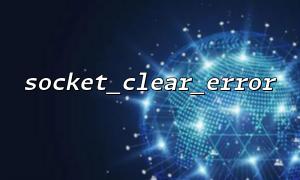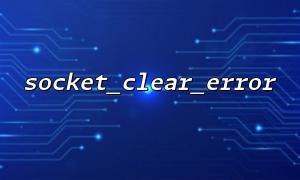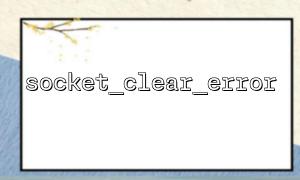In PHP network programming, Socket is a low-level communication method that allows developers to have more control over data exchange between clients and servers. However, because of its low-level nature, developers must handle resources and error management on their own. This article discusses a common but often overlooked issue: the consequences of forgetting to reinitialize a socket after calling socket_clear_error().
socket_clear_error() is a function provided by PHP to clear the error state recorded from the last socket operation. It is usually used in conjunction with socket_last_error(), which retrieves the error code from the most recent socket operation.
Usage is as follows:
$socket = socket_create(AF_INET, SOCK_STREAM, SOL_TCP);
if ($socket === false) {
echo "Creation failed: " . socket_strerror(socket_last_error()) . PHP_EOL;
socket_clear_error();
}
The purpose of this function is to help developers distinguish whether the error that occurs during subsequent socket operations is new or left over from a previous operation.
Many developers, when facing a failure in socket creation or connection, habitually clear the error code and then proceed to use the socket object for the next operation, such as reconnecting or sending data. However, if the socket is not reinitialized, this approach can lead to a series of problems.
Consider the following example:
$socket = socket_create(AF_INET, SOCK_STREAM, SOL_TCP);
if ($socket === false) {
echo "Socket creation failed: " . socket_strerror(socket_last_error()) . PHP_EOL;
socket_clear_error();
}
<p>// Forgot to reinitialize the socket<br>
$result = socket_connect($socket, "m66.net", 80);<br>
if ($result === false) {<br>
echo "Connection failed: " . socket_strerror(socket_last_error()) . PHP_EOL;<br>
}<br>
In this scenario, if socket_create() fails and returns false, the subsequent socket_connect() operates on an invalid resource, which not only fails but may also trigger a PHP warning or even interrupt the execution of the program.
If an invalid or corrupted socket (i.e., false) is passed into functions like socket_connect(), socket_send(), or other socket functions, it will lead to serious runtime errors.
Clearing the error code without fixing the underlying issue (i.e., the invalid socket) can cause confusion in subsequent error messages. Developers may overlook the real cause of the issue while troubleshooting.
In an environment with multiple concurrent socket operations, an uninitialized socket participating in I/O processes may lead to incorrect data transmission and business logic errors.
After calling socket_clear_error() to clear the error code, make sure to check if the socket needs to be reinitialized:
$socket = socket_create(AF_INET, SOCK_STREAM, SOL_TCP);
if ($socket === false) {
echo "Creation failed: " . socket_strerror(socket_last_error()) . PHP_EOL;
socket_clear_error();
$socket = socket_create(AF_INET, SOCK_STREAM, SOL_TCP);
if ($socket === false) {
die("Socket creation failed again: " . socket_strerror(socket_last_error()));
}
}
$result = socket_connect($socket, "m66.net", 80);
if ($result === false) {
echo "Connection failed: " . socket_strerror(socket_last_error()) . PHP_EOL;
}
This approach prevents subsequent operations from using an invalid or undefined socket state.
socket_clear_error() is a helpful tool to improve error handling precision, but it does not fix the underlying issue with the socket itself. In actual development, always remember: once a socket creation fails or becomes invalid, it should be reinitialized instead of continuing to use the old resource. Otherwise, it may lead to communication failure, program logic disruption, or even security risks.
Developing good error handling and resource management habits is key to writing robust and reliable PHP network applications.












